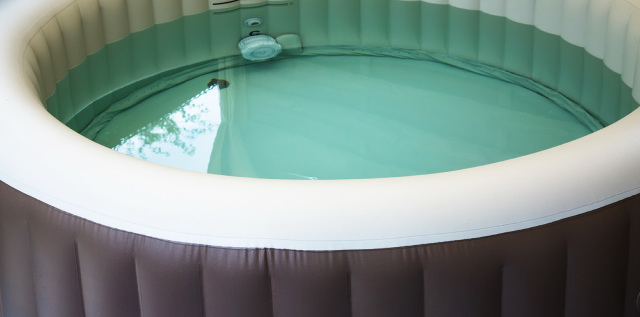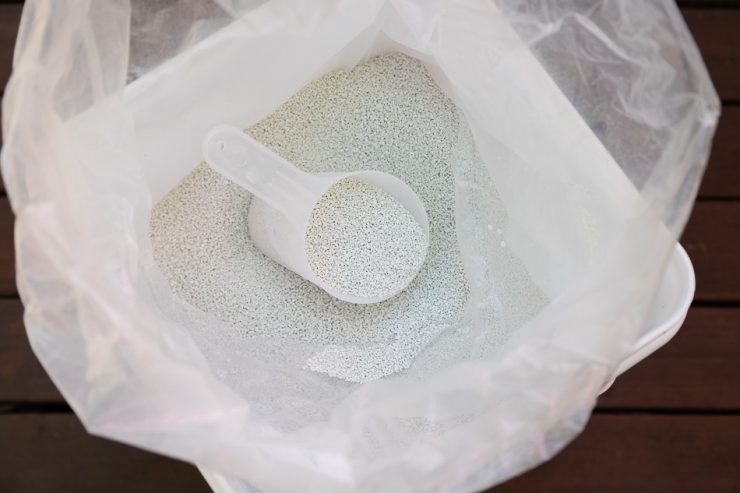Perhaps you’ve either just received a new hot tub or have had a hot tub for a while, and are wondering if shocking is needed. Read on to learn more about the types of scenarios that might require you to shock your hot tub, as well as how to do it and the best products to use.
Shocking hot tubs are needed for various reasons such as disinfecting and clearing the water. It’s best if you use a combination of both chlorine and non-chlorine shocking, but regardless of which, you should seek to shock your hot tub at least once a week.
Understanding when to use chlorine and non-chlorine shocking as well as how to use them is crucial to maintaining a safe and clean hot tub or spa. But first, let’s go over why you should shock your hot tub in the first place.

Article Contents
What Do I Mean by Shocking Hot Tubs?
Shocking a hot tub means adding a large dose of oxidizer into your hot tub water in order to quickly and effectively clean and clear up (otherwise known as shocking) the water. Shocking is not unique to hot tubs as swimming pools need to be regularly shocked as well, albeit with different chemicals.
Related Reading: How To Shock A Swimming Pool For Beginners (In 6 Easy Steps)
Why is it Important to Shock Your Hot Tub?
There are several reasons why you should shock your hot tub such as to keep your hot tub clean and to reactivate sanitizers that assist in killing bacteria. Let’s go into a bit more detail now.
1. Removing Organic Contaminants
One of the biggest reasons you should shock your hot tub is that it can help remove organic contaminants such as hair, shampoo, lotion, and dead skin cells from the water.
Of course, showering and the sanitizers in the water will both help you remove these things, but they’ll only get you so far. As long as small remnants are introduced to the water, without you ever shocking the hot tub, it’ll only be a matter of time before they turn into a cloudy mess in the water.
2. It Helps Kill Bacteria
Shocking your hot tub will help you remove bacteria that are particularly known to cause disease.
Unlike bacteria that can be found in moist places such as on your shower curtain, certain bacteria in your hot tub can cause serious illness. Using chlorine-based shock treatments can help sanitize the water along with other sanitizers that are already being used.
Shocking your hot tub will also assist current sanitizers, which will deplete over time, by giving them a boost. It does this by breaking the bonds that sanitizers can make with organic contaminants, thus freeing them from the pollutants and reactivating them.
3. It Helps Remove Chloramines and Bromamines
Shocking your hot tub will allow you to breathe easier by removing the chloramines and bromamines that are leftover from your sanitizers.
As chlorine and bromine kill the bacteria and remove contaminants, they also leave behind waste products in the water. It’s these waste products that cause a recognizable smell in pools and hot tubs.
By increasing the sanitizer levels back to normal, hot tub shock will remove these waste products and the smells associated with them so that you can breathe easier.
When Should You Shock Your Hot Tub?
If your hot tub is indoors, you can shock it anytime during the day. If it’s outdoors and isn’t under any sort of covering or shade, you should shock it at dusk or night.
The reason for this is that shocking your hot tub will boost stabilizers, which in turn can easily burn off in direct sunlight.
Even if you’re using something like dichlor, which contains cyanuric acid, thus helping prevent it from burning off, you’ll want to minimize the exposure to sunlight. Just to be safe.
Related Reading: Can You Over Shock Pool? Pool Now Cloudy
Should You Shock Your Hot Tub Every Week?
You should absolutely shock your hot tub every week at the very least. If you’re using it heavily, or have several people using it together at once, you’ll probably want to up that to twice a week.
And if you have an outdoor hot tub that gets dirty, you’ll want to regularly shock your hot tub.
How Many Times a Day Can You Shock a Hot Tub?
Once a day is plenty. How many times a day shouldn’t even be something to be considered since you’ll usually only have to shock your tub once a week. In fact, shocking too many times can lead to damaging your tub.
And not just that, you won’t be able to even use your tub, due to the high levels of chemicals in the water.
Do You Need to Shock a New Hot Tub?
It’s not necessary to shock a new hot tub since the main reason for shocking a tub is to return the water quality back to its original state.
If you’ve just started using a new hot tub, then obviously you’ll be putting in sanitizer for the first time and there won’t be any contaminants in the water since you haven’t gone in the tub yet. Adding in sanitizer is enough if you’re just starting out.
Eventually though, once you start using the tub, you’ll have to begin shocking at least once a week in order to restore the water back to its clean state at the beginning.
Which Type of Hot Tub Shock Do You Need?
There are several types of hot tub shocks that are used in the market. Which one you choose to use will depend on the sanitizer that you’re using.
Here, we’ll give you a basic rundown of the hot tub shocks you’re most likely to come across on the market.
Chlorine Shocks
Chlorine shocks are best used after heavy use of your tub. Normally, you wouldn’t have to use chlorine shocks on a regular basis since they can damage your hot tub.
Usually, chlorine shocks for spas, hot tubs, and Jacuzzis are Dichlor. Dichlor is a stabilized chlorine that comes in granular form.

In order to reduce the risk of chemical damage, you should keep the cover off for at least 20 minutes, after adding chlorine shock. Make sure you’re running a regular jet cycle too.
Use For:
- Saltwater hot tubs
- Chlorine hot tubs
- Ultraviolet, Ionizer, or Ozone sanitized tubs
- Bromine hot tubs
Pros:
- Highly effective at removing contaminants
- Can kill bacteria on its own
Cons:
- Can damage the hot tub and any of its accessories if spilled
- Can be harmful to the skin (if you enter the tub immediately after shocking)
- Can’t swim chlorine levels return to normal
| Name | Cost | Pros | Cons |
| OETNAISAN Spa Essentials Spa Shock Xtra Dichlor | $50-$100 | Compatible with chlorine, bromine, and ozone Handle and wide-mouth top allows for easy pouring | Should not be used for inflatable tubs as it can damage the paint and clog the filters |
Non-Chlorine Shocks
Non-chlorine shocks don’t kill bacteria, but rather they oxidize the water so that they remove organic contaminants, thus clearing the water. They also help other sanitizers to do their work more efficiently.
Use this type of shock in your hot tub if you don’t want to raise the chlorine levels too high.
Use For:
- Chlorine hot tubs
- Hot tubs using mineral sanitizers
- Saltwater hot tubs
Pros:
- Softer on the body and hot tub since it’s not a disinfectant
- Removes contaminants and promotes sanitization without being harmful
Cons:
- Not as effective as chlorine shocks in removing bacteria since these aren’t disinfectants
| Name | Cost | Pros | Cons |
| Non-Chlorine Spa Shock for Hot tub | Under $50 | No pre-dissolving needed | Not as effective occasionally for extremely cloudy water Might cause a reaction in the water causing it to turn light-green |
Related Reading: Which Pool Shock Should You Use? (answered!)
How to Shock Your Hot Tub
Regardless if you’re using chlorine or non-chlorine-based shocks, the process is relatively similar:
- Remove your hot tub’s cover and keep it off so that oxygen from the shock can reach the surface.
- Test the water to make sure the pH is balanced.
- Turn on the jets or blower to aerate and circulate the water.
- Depending on your shock, you may require about 17 g of non-chlorine shock for 1,500 L of water or 35 g of chlorine shock for 1,500 L. This will vary based on your particular product, so read the label carefully.
- Carefully pour the treatment into a chemical-resistant measuring cup.
- Pour from the cup into the hot tub near the water inlets.
- Wait at least 20 minutes for the water to circulate and mix the shock in.
- Test the water. When the sanitizer levels are in the correct range, it’s safe to swim again.
For chlorine-based shocks, aim to keep the chlorine level at 1-3 ppm with 2-3 ppm being ideal.
Remember to wear safety gear (goggles, chemical-resistant gloves, etc.) during the whole procedure!
Final Thoughts
We’ve gone over a lot of information in this article, but the simple answer to our question is yes, you should shock your hot tub for a number of reasons. Though you may find it tedious, you’ll be sure to enjoy the results in the long run.
Related Reading:
Can You Fill a Hot Tub or Spa with Well Water?
How to Raise Alkalinity in Hot Tub (Alkalinity is Low)
Soda Ash vs. Baking Soda for Hot Tub: Which is Better?
Chlorine Vs Bromine for Hot Tubs (Which is Better?)



